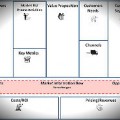In previous posts (part 1, part 2 and part 3), we saw what the MVP marketing plan was about and went into details about each box. The MVP marketing plan is a quick way to plan, organise and keep track of your MVP marketing activities. These activities include any and all of the market experiments you will be doing to find your product/market fit.
Before you start filling out the boxes of the MVP Marketing plan you will need to gather some information.
Setup – First version of your MVP
If you are at your first version of your MVP then you’ll need to sit down and do a proper mini-marketing plan. The content of this plan will vary according to your type of business, your product or service and the market(s) you are going after. The basics you will need to cover are the following;
- Target market
- Who will be buying your offerings (hypotheses, customer profile, persona, etc.)?
- What are the needs of your buyers that your product or service will answer?
- How do you define your market segments?
Approximately how many customers do you realistically think will buy your offerings in each segment (what hypotheses, market information and math are you using to get to these numbers?)
- Product or service
- What is your product or service?
- How will it better answer the needs of the buyers you are aiming for than how they are satisfying their needs right now?
- Customer experience
Map out the entire experience your customers will have while interacting with your organisation and your product, or services.
At each touch point, flesh out a typical interaction. This exercise takes a while. Once you are done with it however, I guarantee you will have insights for every single aspect of your MVP marketing plan that will not only accelerate future decision making exponentially, it will enable you to make better decisions all around.
This is also where you will figure out your various customer service needs (admin. and tech.).
- Price
How much does it cost to produce each unit of product or service? Here you will calculate all of your expenditures, including any that you are not dishing out hard cash for during your calculation period but will need to eventually, and divide it by the conservative estimate of number of sales you will have during a period that makes sense for you (*). The number you get plus what you consider a reasonable profit margin should be the very lowest price you charge for your product or service. If your target market cannot bear your minimum price, you need to find a way to reduce this number before hitting the market with your MVP or find a new target market.
This is where you need to itemise all of your current and forecasted expenditures, if you haven’t done so already. Accounting can be tedious but it is essential to master it from the get go if you want your organisation to survive after your runway (**) runs out.
Forecast your sales revenues, number of sales and costs on a weekly or, at minimum, monthly basis.
- Distribution
List all of your distribution channels and the people you will be dealing with to run these channels for each MVP. If some of these channels will not be available at all times, make a calendar and sketch out which channels will be available when.
It is important to go into detail with your distribution channels. If you sell with the help of a face to face sales team (even if its friends/family who are not being paid), on the web, via your own web site, an Amazon store and via referrals on 5 other sites, you need to do the exercise for all 8 distribution channels.
Furthermore, if you use logistics suppliers (web or brick & mortar based), you need to include them in this section of your plan. They are key parts of your distribution channels and will also be impacted when you start doing promotions or marketing-communication activities.
- Promotion
Jot down ideas as to how you will get your market feedback for your next few iterations of your MVP. Also include any promotional/communication activities you will need for funding purposes. Finally, if you are anticipating any activities to get your brand out there, also include them here.
If you’re not at your first MVP iteration – Download canvas
Gather all the information described above and organise it so you, and the rest of your team, have easy access. Complete any missing information.
You can download a MVP marketing plan canvas pdf here. You can also find larger images of a canvas and a full MVP marketing plan.
Sticky notes. Sticky notes everywhere
Now that you have the basic information you need, this is the material required  to start using your MVP marketing plan
to start using your MVP marketing plan
- Poster board (22’’X28’’ or larger). Optional
- Sticky notes (as many colours as you have activities or customer segments)
- Pencil
- Brains (preferably with accompanying bodies), as many as you can gather
Draw the boxes of the MVP marketing plan on your poster board. Hang it on your office wall in an easily accessible and very visible place.
You also can draw the MVP marketing plan directly on the wall if you can stick notes on the surface.
Colour-code your marketing activities, if you will be running more than one for each MVP iteration, or your market segments (if you chose to have one board per activity), by using a same sticky note color for each of them.
Write a single idea on each sticky note. It may be hard at first to summarise your entire idea so that it will fit on one side of the sticky note. You will get very good at it with time.
If you are good at drawing, you can also draw out the idea. You can also use pictures or any other means of visual communication that you can somehow stick on your MVP marketing plan that will get the message across.
Your ideas will usually pertain to a single topic on the plan. Before you start to write your idea, you can put the initial of the box it will be stuck on in a corner of the sticky note. This will make using the notes in the future much easier and it also helps to know where to stick it back when a note falls to the ground.
If your sticky note pertains to more than one of the boxes, simply write the initials of all of the boxes the topic pertains to and stick it on the board where it makes the most sense.
Keep a supply of sticky notes and a pen near the poster board. You can even make a hole on the board, put a cord through it and hang a little pouch or plastic bag that will hold your supplies.
The more you use your MVP marketing plan, the more you will find ways to make it work for you. You will inevitably forget to put some of your ideas on the board. No worries, just stick the missing note on it when you think of it. It will usually take you less than 30 seconds to do so. Like any other management tool, it takes a certain amount of discipline to use it. Fortunately the MVP marketing plan is the management tool that requires the least amount of discipline that I know of.
Don’t throw it out
Finally, when you are done with a specific marketing activity, or you’re at your fourth layer of sticky notes on the board, put the notes in an envelope or folder clearly marked with the name of the activity as well as the weeks, month(s) and year during which the activity ran.
These notes will be very useful when you’ll need to write out a full marketing plan. It will also help you see your evolution over time or specific patterns emerging. Sometimes, it will even remind you of really good ideas you had in the past.
If you have any questions on how to use the MVP marketing plan you are welcome to contact me.
Finally, as I’ve been using this tool for my own business and with my customers it is becoming apparent that a digital version of the MVP marketing plan that would allow the following would be awesome.
- Fast recording of the visual notes (by all contributors), with an option to tie the notes to additional material
- Collaboration features that enable discussion before posting a note
- Permanent viewing/projection of a real-time board in a single or multiple locations
If you feel like this is a project you would be interested in for your own business, please contact me.
(*): If you can find average profitability margins for your sector you can go with those.
(**): A runway is the period of time a start-up has before it starts to generate sufficient revenue to cover all of its expenses.
Techno Marketing fait relâche jusqu’à la mi-mars.
Techno Marketing is taking a break until mid-March.
EDIT (Sept. 2016) – Added a link to download a pdf of the canvas












